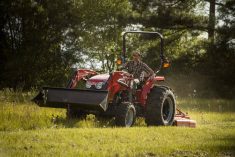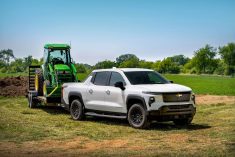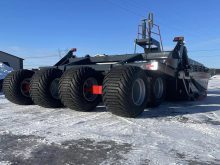Expensive, heavy, complicated seeding machines are being challenged by lower-cost, high-speed compact-disc machines and good old-fashioned shank cultivators with narrow knife openers.
Over the past two decades, one of the devices that’s become popular among farmers with simple seeding systems is the Technotill (TNT) packer. Although the original Version 1 TNT functions well and continues to pack seed on millions of acres, company president and inventor Betty Schoenhofer says the time had come to upgrade the design.
In the process of re-engineering, she worked with a number of long-term customers representing decades of field experience with TNT.
Read Also

Growing garlic by the thousands in Manitoba
Grower holds a planting party day every fall as a crowd gathers to help put 28,000 plants, and sometimes more, into theground
She said farmer Kevin Horner of Blaine Lake, Sask., has been a valuable source of advice over the years. Schnoenhofer provided him with a set of Version 2 TNTs for testing in wet conditions last spring.
Horner said the most obvious benefit of the new design is the fact that the seeder now pulls straight. The Version 1 packers had the fertilizer wing on one side, which created side force that pulled the entire cultivator frame to the side. Two fertilizer wings solved that.
“One thing has remained the same, and that is we don’t get very much soil movement with Technotills,” he said.
“You get the packing done before the soil flows back into the trench.”
This arrangement is especially valuable in wet conditions.
“On a normal seeding system, in wet conditions you get the seed put in, then you get that packing wheel coming along,” he said.
“It packs everything too tightly and seals everything up so the plants can’t emerge. Then you get the depth control all bunged up so your seeding depth is all wrong.”
Horner doesn’t think the complexity of big air drills is merited. He said simplicity is best and that you can’t find seeding equipment any simpler than the Technotill system.
“I just bought a new air drill this year. I got a 62-foot New Holland ST830 cultivator. I installed Betty’s new Technotill packers. You can compare my crop to anybody else’s around here seeded with a SeedHawk or SeedMaster or any of the other high-tech drills,” he said.
“Everyone’s asking why I bought a cultivator. I tell them it’s simplicity. I have no moving parts in the seeding system. When I want to change depth, all I have to do is turn one lever, give it a couple cranks and I drop another half inch. I have one cylinder that lifts the whole 62 feet. I have plenty of trash clearance. I’ve used Technotill packers for many years, so I know they work better than anything else.
“My cousin runs a SeedMaster. They have to run all that straw through their combine and then harrow the hell out of it in order to get it to pass through their drill in the spring. With the cultivator frame seeder, I don’t even need to harrow.”
His ST830 is on 12-inch row spacing with a 3/4 inch knife. He leaves cereal straw eight to 10 inches and canola knee high. He said it all flows right through with no plugging.
“I see some big farmers are switching back to simpler systems,” he said.
“It’s all because of trash management and because of these wet conditions we’ve experienced. Guys with those high-end drills admit they’re having real problems with depth control in wet fields. Plus, you can sink those heavy rigs and get them stuck badly.”
Horner said he typically starts spring seeding with a half-inch seed depth and half-inch soil over the seed. As the moisture gradually evaporates out of the field, he goes deeper. By the end of seeding, he’s often down to two inches with the seed, but he’s still packing exactly one half-inch soil over the seed. Light fluffy soil then falls into the trench, but it’s not packed.
Horner said Schoenhofer recommended a packed soil cover ranging from 1/4 to 3/8 inches, but he prefers 1/2 inch. Regardless of how deep you go to find moisture, the seed always has the same thin soil pack over it, he added. Above that it’s all fluffy soil, which the young seedling penetrates easily.
“In sandy soils, the top two inches get pretty dry, so you put the seed down … into the wet bed and pack it there. The plant emerges into this furrow or trench, and it’s protected, so it doesn’t get sand blasted by the wind,” he said.
“The other thing I tried is seeding directly into sod, pasture and hayland. I don’t put a cutting coulter at the front. It’s just the 3/4 inch knife. I put it down to an inch and a half. It keeps the furrow open so the plant can emerge. If you followed with a packing wheel, you’d be screwed because you’d close it up and the seedling would be trapped under the sod.
“So far we’ve sod-seeded 600 acres. It was alfalfa and grass for 10 years. We sprayed glyphosate the fall before. The next spring we put in wheat. We had some other fields with sod that we broke up because we thought it would be easier seeding. You couldn’t tell the difference between the field we sod-seeded and the field we had broke up. Wasted our time and money breaking up sod.”
Farmer Wayne Cubbon from North Battleford, Sask., worked on the TNT design with the Schnoenhofers from the very start.
“Wayne gave us a lot of assistance and engineering advice over the years,” Schoenhofer said.
“He has two seeders equipped with TNT. He ran a full set of Version 2 this spring on one machine and the original Version 1 on the other machine. He’s in the best position to compare the systems.”
Cubbon has a pair of Flexi-Coil 830 deep tillers, both running TNT 1 until this spring, when Schoenhofer provided him with a full set of prototype Version 2 packers for one of the machines. He said two fertilizer orifices let him spread the fertilizer over a broader area.
He said the holes are bigger, which eliminates fertilizer plugging. That had been an issue with TNT 1 because all fertilizer went through a single hole.
A lot of small changes have been made that people might not notice if they had not been part of the design team, he added.
“I helped Betty with the design on these new packers, so I can see all the changes. In fact, I helped Walter and Betty when they were designing the first Technotill packers years ago,” Cubbon said.
“On the new ones, the holes are no longer round. If you look closely, it’s more of an oval shape. And the pitch is different. Now they shoot the fertilizer to the bottom, whereas before the fertilizer just sprayed into the soil bank.
“I think the main thing is that now the frame pulls straight. The old ones had that carbide ear on just one side so they twisted the machine a little bit sideways. That’s gone now. Now they pull straight behind the shanks.”
Cubbon said the plates on the new Version 2 are locked into position. With the old ones, the plates could get knocked sideways making a turn. The new plates are thicker, so the Version 2 units gave him better packing in the dry conditions he encountered this spring.
He seeded only one field with both versions 1 and 2 in the same field at the same time. He didn’t have time to organize an actual comparison, but he did note that there was no visual difference in emergence between Version 1 and Version 2.
He thinks the main benefit will be straight pulling and better fertilizer distribution. With the single chute TNT, he would occasionally get leaf burn.
“I started with the original ones Betty’s husband made. I only used them one year, and I had some ideas about how to improve them. But then Walter passed away in 2004.
“Finally, I talked to Betty to explain what we could do to make them better. She made up some prototypes for me, and I ran those for a year and they worked a lot better. So then she incorporated those changes into the production units.”
He said that was back when all the prototypes were handmade iron. This time around, she feeds a new design into the 3D printer and it gives her a plastic prototype that’s strong enough to test in the ground without breaking.
“This really speeds up design research. You can run an opener in the bin and see where you can make slight tuning changes, and then print out a fresh plastic copy to see how it works,” he said.
“On one of the first plastic prototypes, the angle was a little too steep so the dirt was flying away just a little too much. So she made some small adjustments to the shape and printed out another unit that make the dirt flow over the packer. That little tweak gives us a nicer field finish. And that’s good when we’re spraying and combining.”


















